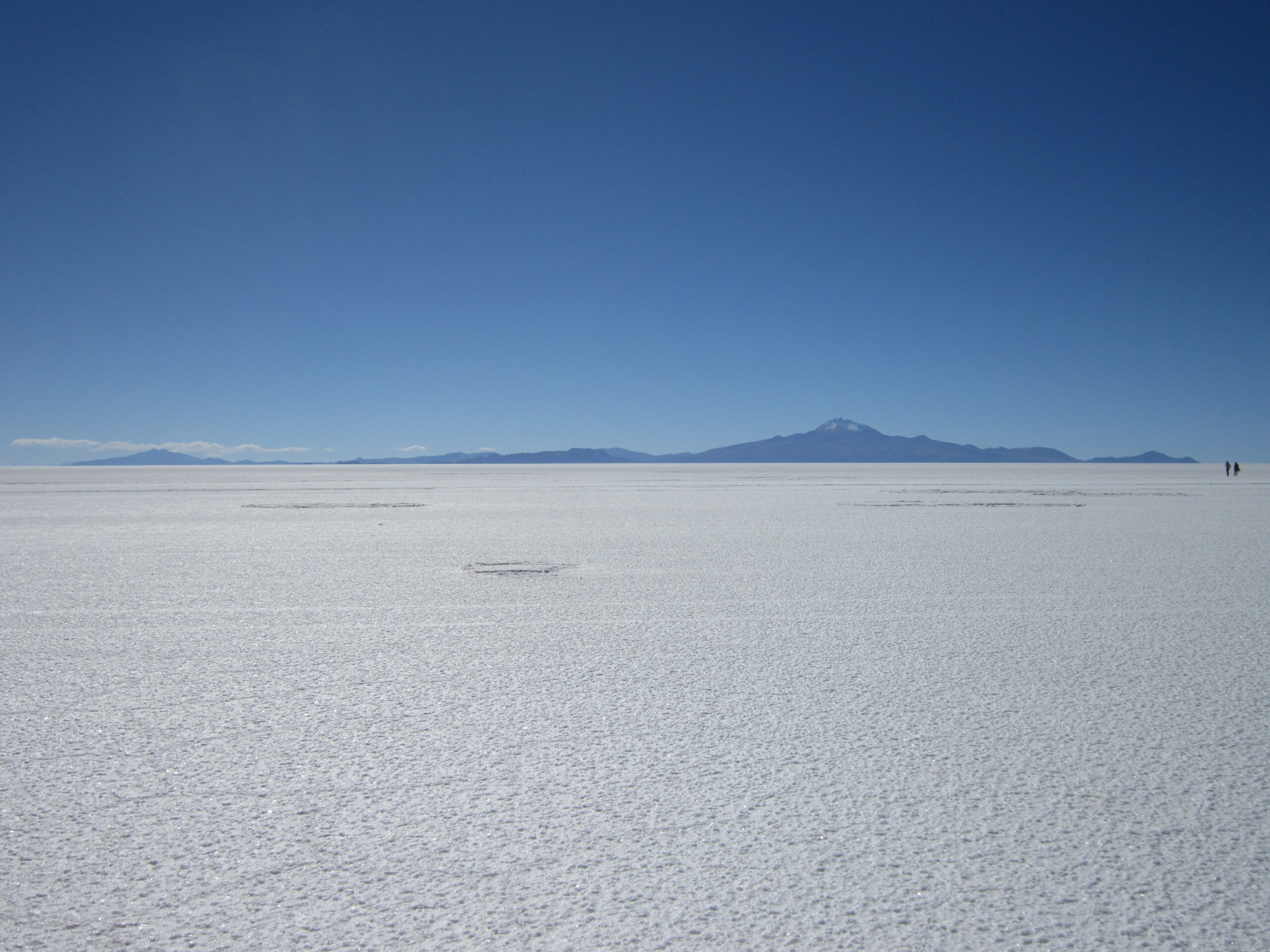Visiting the Old Town of Riga, I picked a spectacularly wild day. As I approached from the city centre just about everyone walking by had a marathon bib on, and steady stream of kids were adorned on medals.
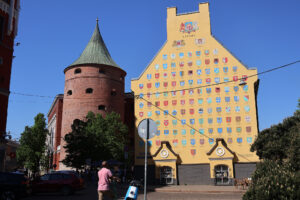
At the freedom monument, marking the entrance from new to old Riga, it seemed like the entire city was here. The first day of the Riga City Marathon had begun, and awards were being given out in front of the monument. Not to be harsh to the kids but it sure looked like this was a participation trophy event. I mean, just how many people can be 1st, 2nd, and 3rd place in a marathon? Apparently the answer is everyone under a certain age.
Thinking that was the reason so many throngs of people were here, even for a Saturday as the usual tourist crowds pestering about following their leader waving a flag, more and more people began filling into the Dome Square, the central area of old town with Riga Cathedral looming over. Both myself and the clock tower above watched curiously to see what would unfold.
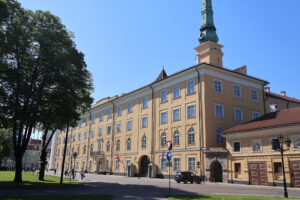
A sound system and a giant screen had been erected in the square. After a sound test with death metal music (great choice), in moments Dome Square was absolutely filled with people, plastic beer cups and cigarettes in hand. And on the screen, the ice hockey played. Yep, ice hockey. I had no idea that Latvia had a huge ice hockey following, and I was told by locals it’s their biggest sport and they have the most fanatical fan base of any country in the world (I was even shown a photo of a famous Latvian player in a selfie with an adoring fan). As Latvia and Sweden faced off in the ice hockey world championships, I actually got into this. It appears to have no rules, just beat the shit out of the opposing side and get the puck in the net. I looked up the score later that day, Latvia lost 2 – 7.
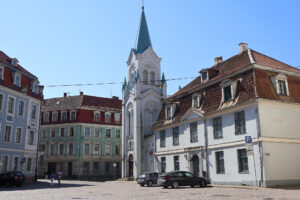
Riga dates back to 1201, and like it’s friends to the north in Estonia, it had turns being controlled by the Germans, Swedes, and of course the Russians. Vecrīga, or Old Riga, is a UNESCO World Heritage Site, and for good reason. Just close your eyes and think of a medieval European town, and opening your eyes this is Vecrīga.
Leaving the square to search for a restaurant that wasn’t packed to the rafters with the hockey faithful. Just when I thought I’d gotten away from the hoards, I stopped to have lunch at the Rock Cafe, which as it turns out this street is some kind of buck and hens party throughfare. I’d stumbled on ground zero for partying pre martial celebrations.
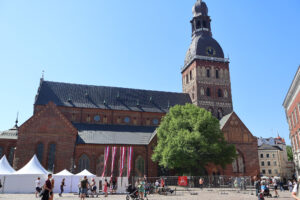
Across the road a large group of rowdy bucks party goers drank the afternoon away, while the buck ran around racing pedestrians, trying to get a ride on a Harley with a bikie (a potentially life ending maneuver), and finally a hens party came by on a bizarre pedal contraption where 10 drunk women peddled the thing and drank beer. The buck naturally had to mount the vehicle, as the women gleefully egged him on and sang songs together.
It was all a bit much, yeah old grumpy man speaking here, but jeez did I have a good laugh at the bucks antics. And it was all in good humour too, everyone was just having a stupid level of fun.
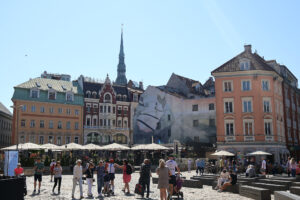
The highlight museum here is the war museum. It gives an incredibly detailed account of the first world war and Latvia’s involvement under the banner of Soviet Russia. The war antiques and the photos, news article’s from the time, and leading to Latvian’s War of Independence from Russia, is just so well presented and overflowing with information. Oh and its free. The first museum so far with no entry charge. I can’t rate this place highly enough.
Although I do think the Latvian military are funding this museum. Uniformed army officers manned the security room, and each floor had promotional posters encouraging you to join the various armed forces. And so, after giving my personal details, bank account, and birth certificate to the army lady blocking the exit, I left feeling pretty confident I hadn’t signed up to anything.
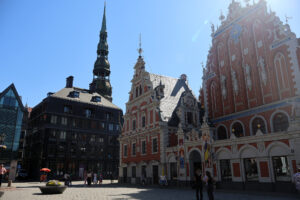
Onward to the House of the Blacks Heads, which was once the home of the Brotherhood of the Black Heads. A trade guild and religious society who would remain unwed due to their travel obligations, with Saint Mauritius as their patron. It would also serve temporarily as the home of the Latvian president and cabinet.
Now the first thing to notice is the name. Black Heads. Once you enter the building, dating back to 1334 and restored in 1999, its hard not to notice the comically African visage inspiration. The halls are adorned with literal black heads, busts (mostly) and statues of African men and women, their coat of arms even with a caricature of a black mans head.
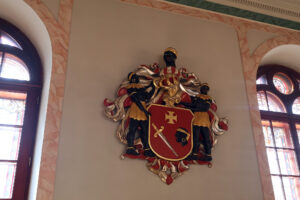
I didn’t know what to make of all this. Did the order dress up in black face? Was it run by Africans? Why black heads?? On the top floor of the ornate house (really a mansion), a plaque presented this question for me, along with the answer.
You see, Saint Mauritius was the first black Christian. Born in Thebes, Egypt, in the 3rd Century CE, he would face the chopping block in 287 CE on order of Emperor Maximian for mutiny by not following orders to attack a town full of fellow Christians. Mauritius would find sainthood sometime in the next century (I couldn’t find a actual date) for his courage and faith in defiance of the pagan Emperor. And so with a healthy dose of irony, he became the patron saint of Holy Roman Emperors.
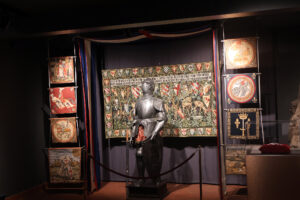
Note: If you look into the history of Saint Mauritius, it’s all very questionable. He was actually a white man for a thousand years, and for unknown reasons in the 13th Century he suddenly started being depicted as black. There’s very little factual history about him.
Heading south and back to the bus terminal, the Riga Central Market is a sprawling shoppers wet dream. Fruit and vege stalls sell the most ripe inviting produce I’ve ever seen. Strawberry’s in particular are in abundance, the deep red flavour grenades just ready to burst with juicy happiness.
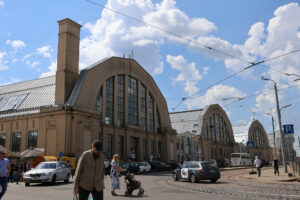
The outdoor stalls are dwarfed by four WWII zeppelin hangers. To house those helium filled deathtrap airships, these hangers are bloody huge. And now, 80 odd years after WWII, they’ve gone from housing instruments of war, to an incredible collect of food, trinket, booze, and clothing stalls.
My favourite was the meat hanger. An entire zeppelin hanger filled with meat after meat stalls. Mostly fresh raw meats, along side dried and cooked. The aroma had my jaw dropping and salivating. If the Russians invaded right now, this is where I’d want to be trapped before happily dying.
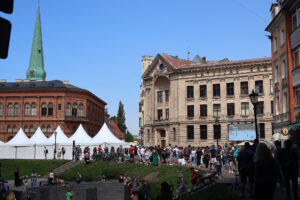
The gastro hanger was another impressive one, mainly a giant food and beer court. At 11:30am dudes were already sitting around with pints, and after deciding to join and try a local craft beer called Labietis, I soon realised the drunks around me were all English. Even though I had a good chat with the bar tender about their local brewery, just 20kms outside Riga, I was eager to get away from the drunk Brits.
It was time to do a trip out of Riga, and Sigulda was in my sights. With a train every hour, I rocked up to the central train station the next morning, bought a ticket, and was eager to see what awaited me there.
